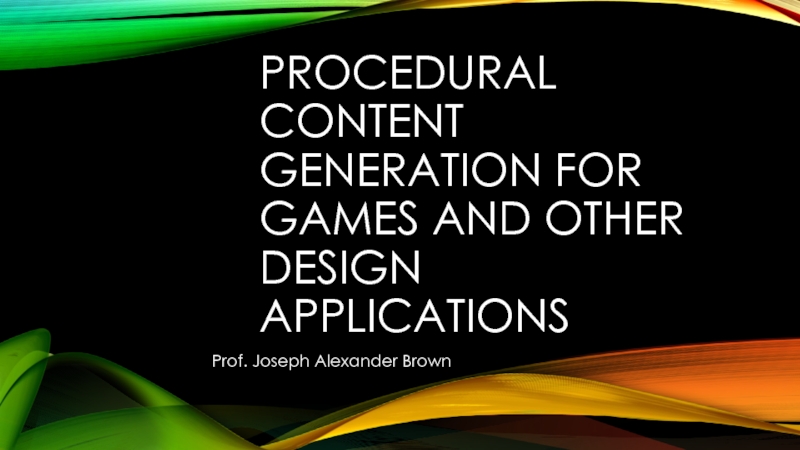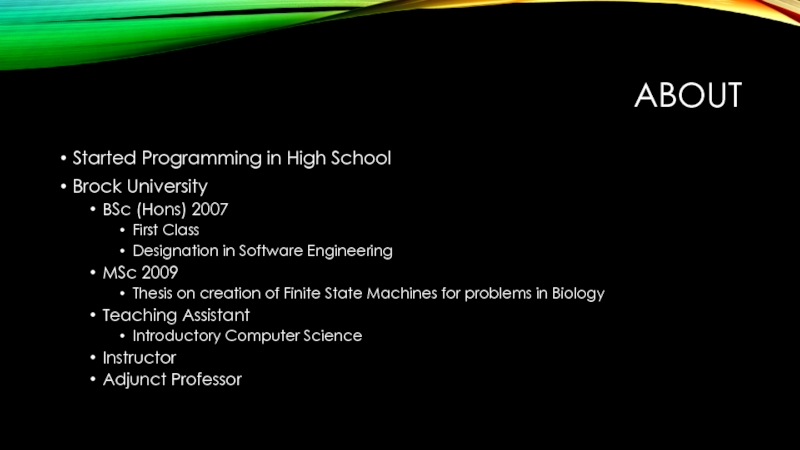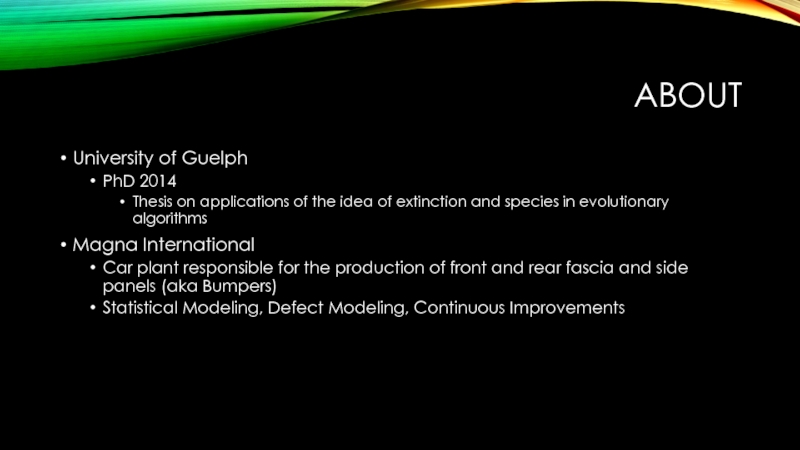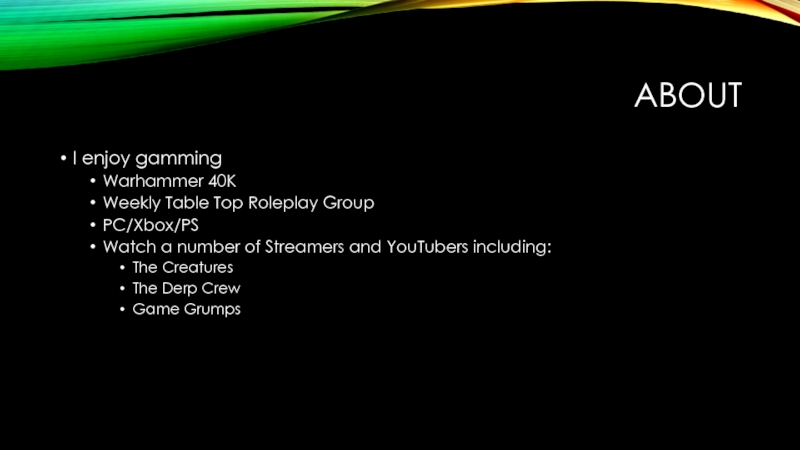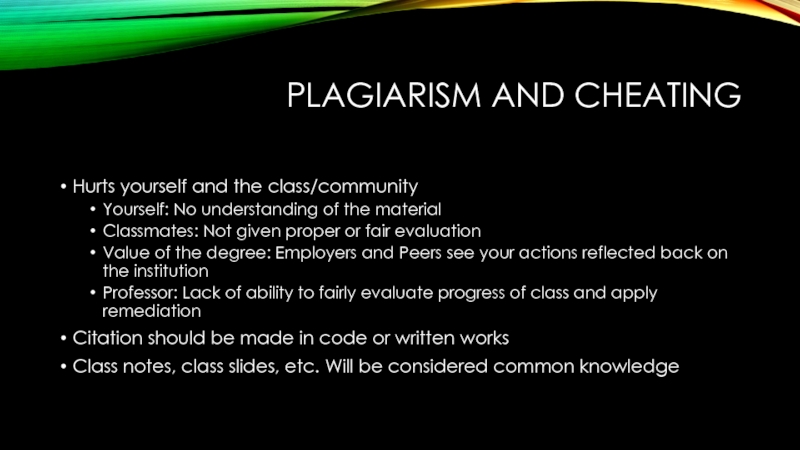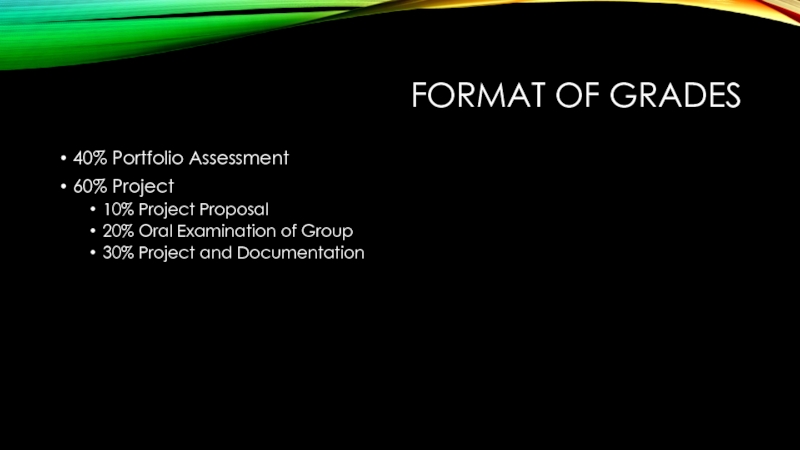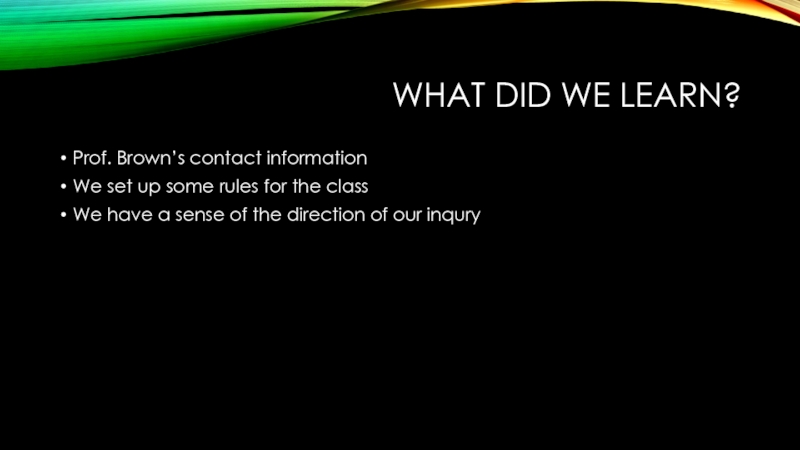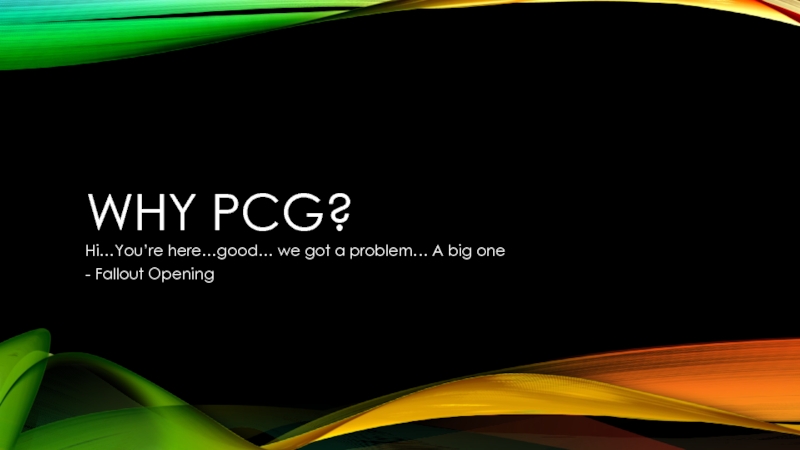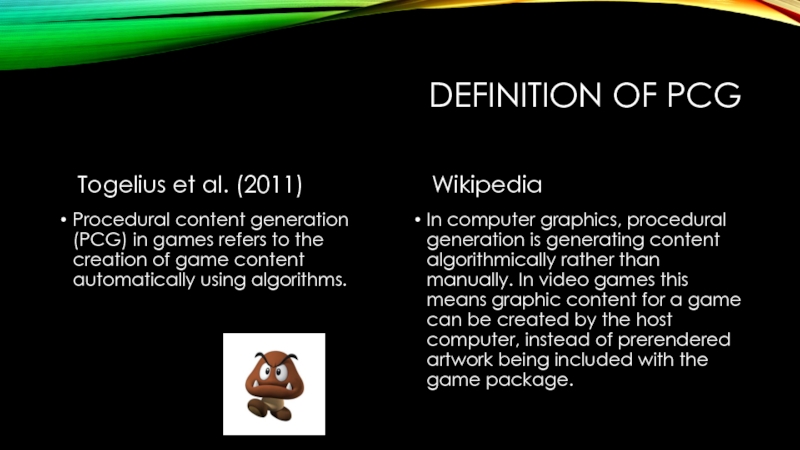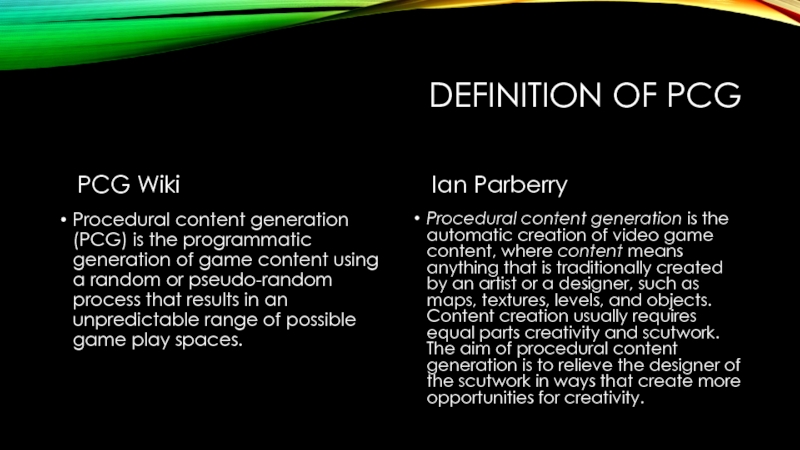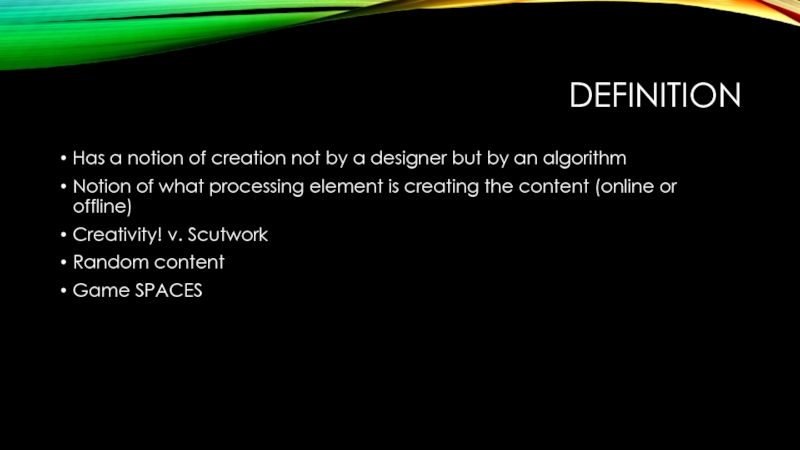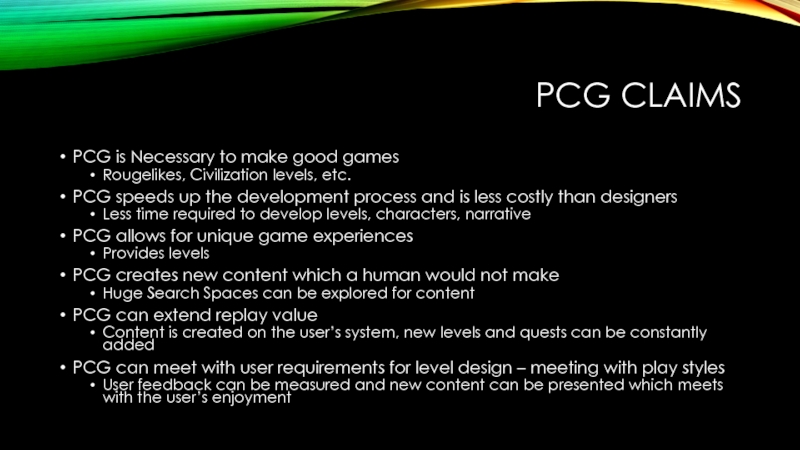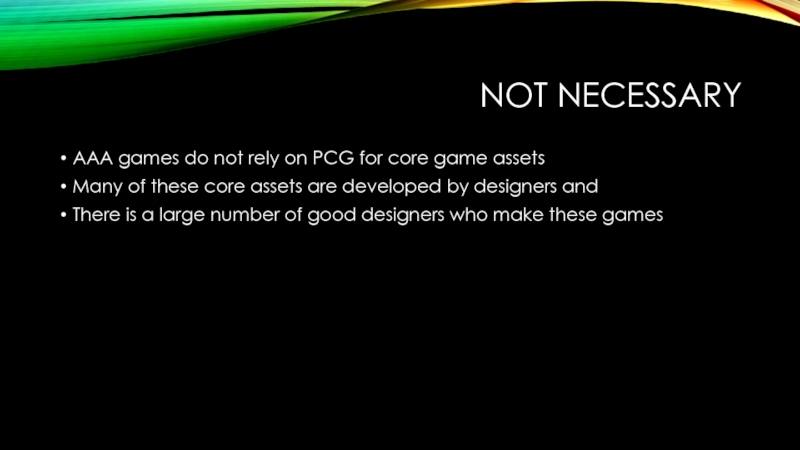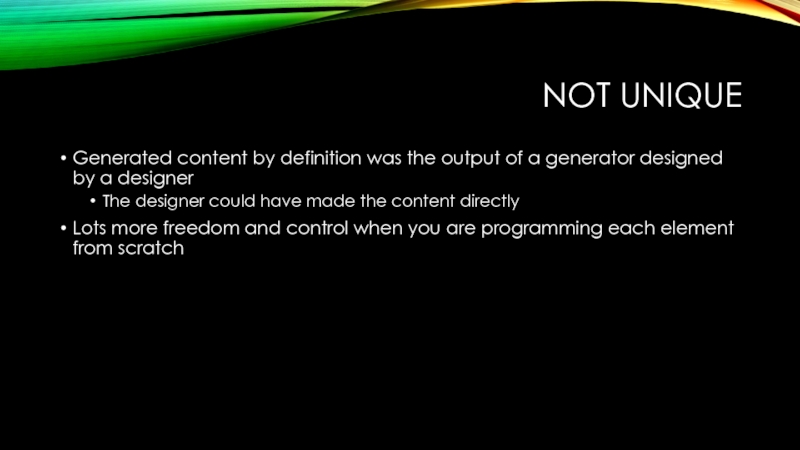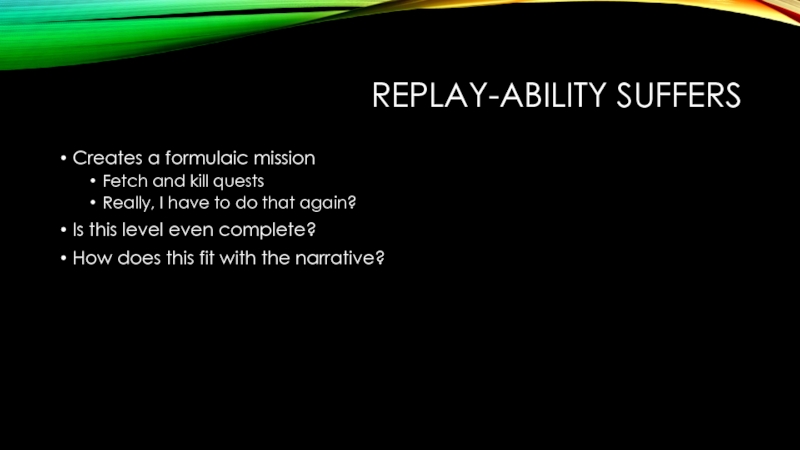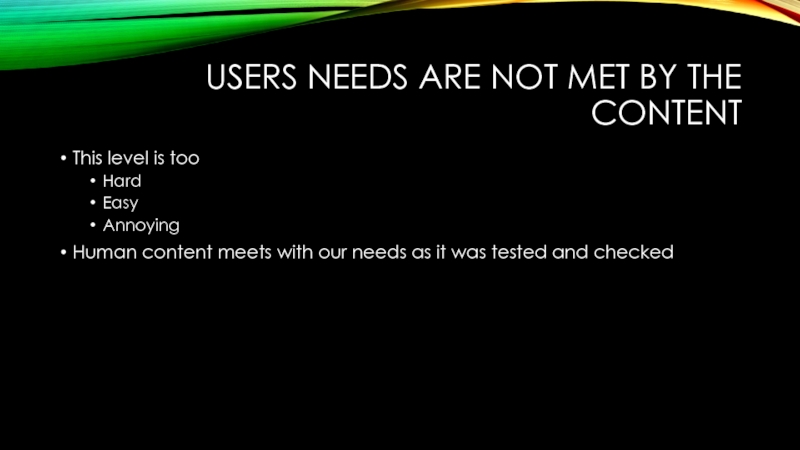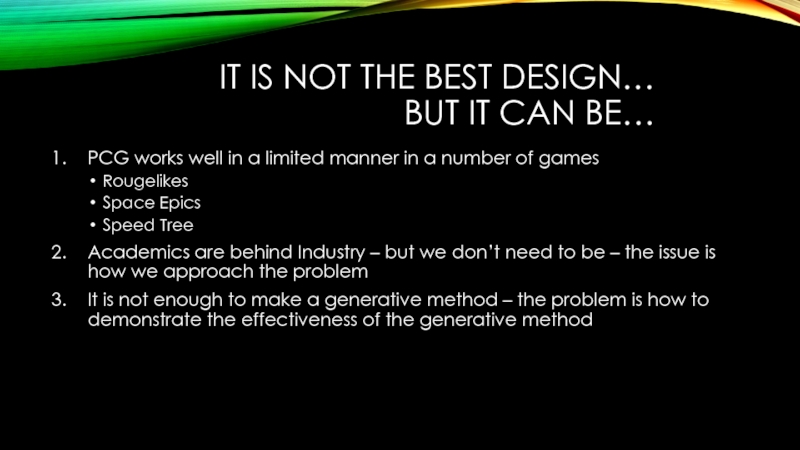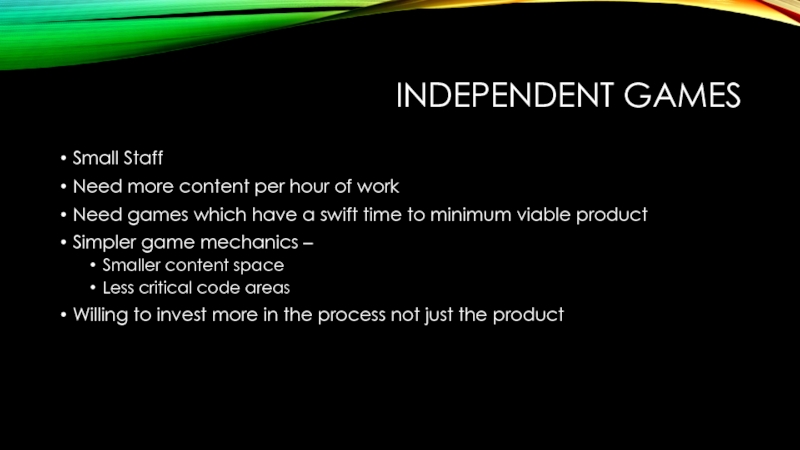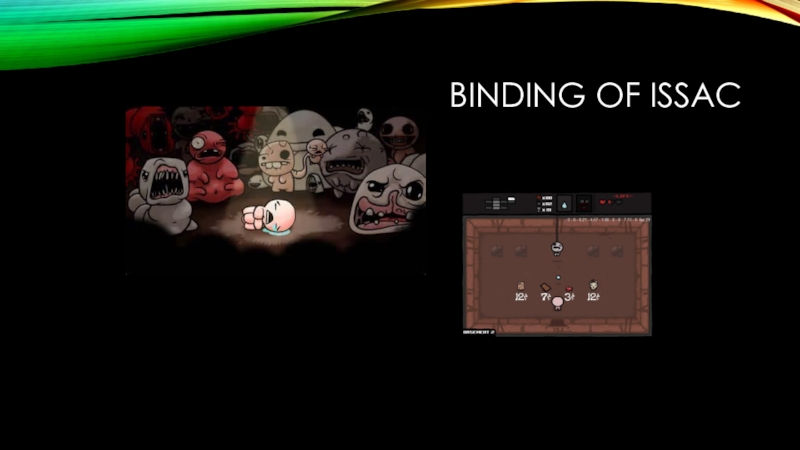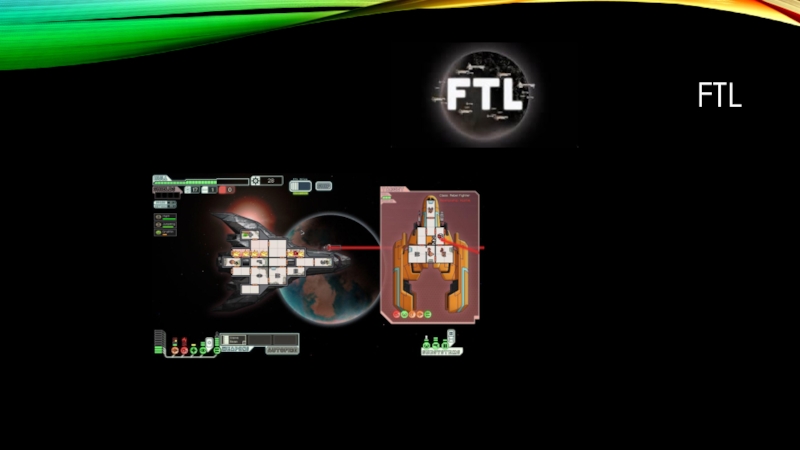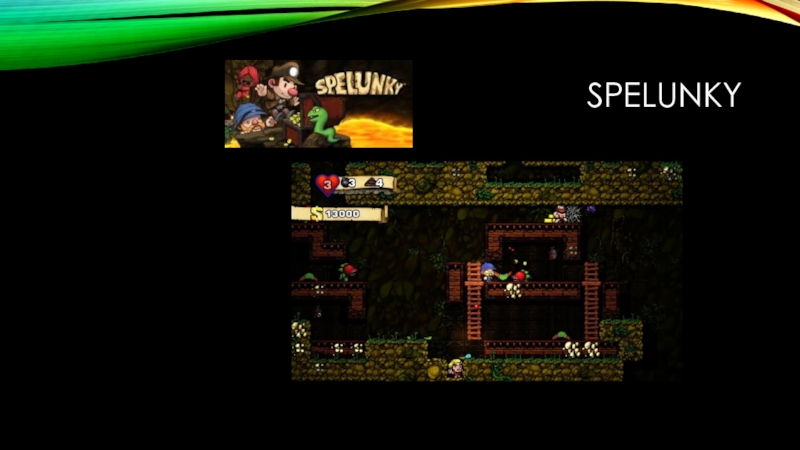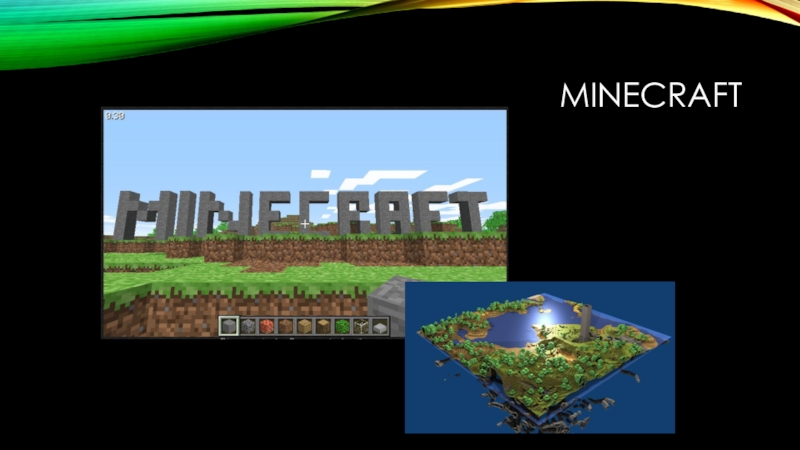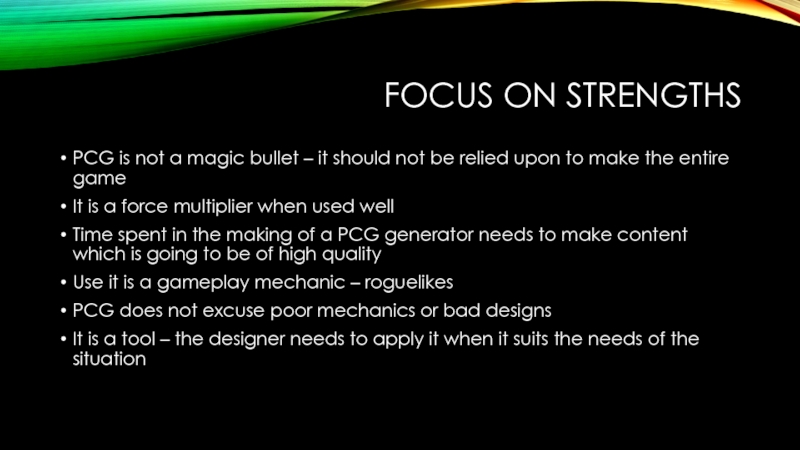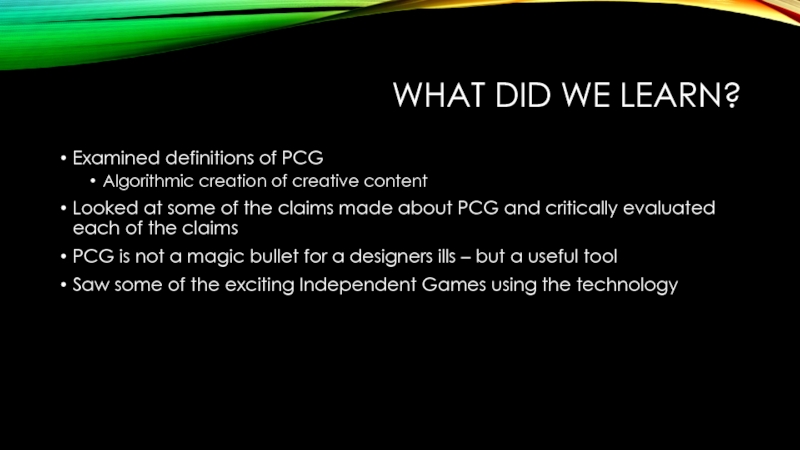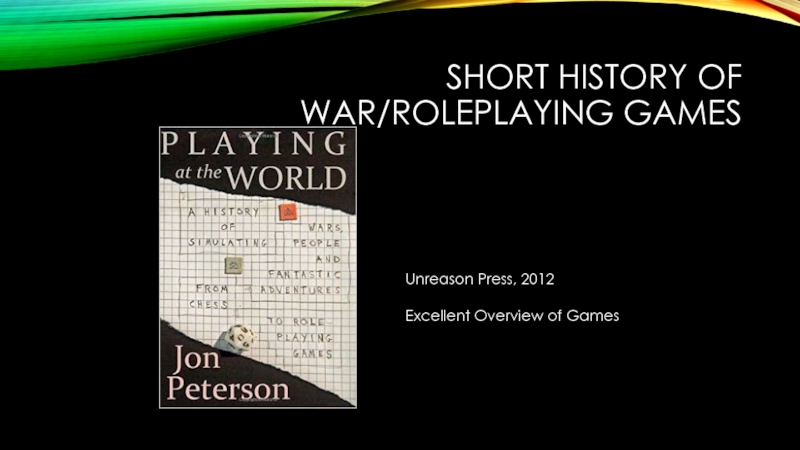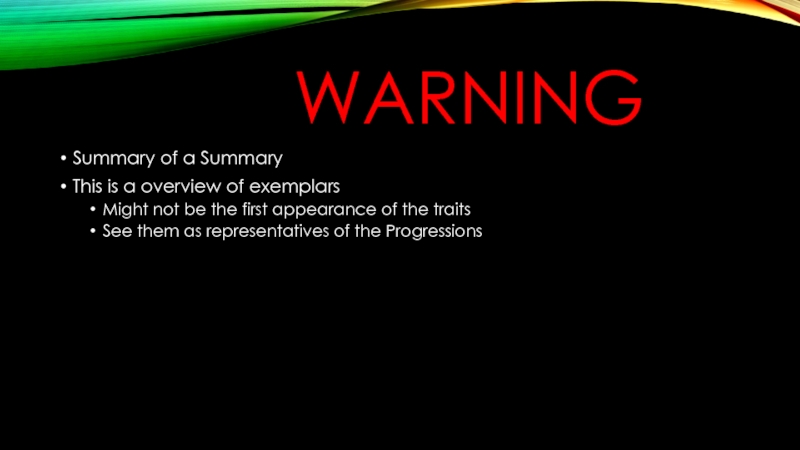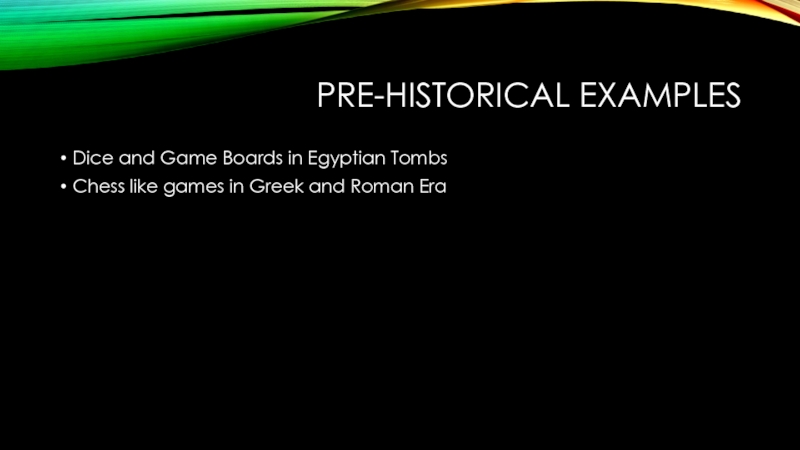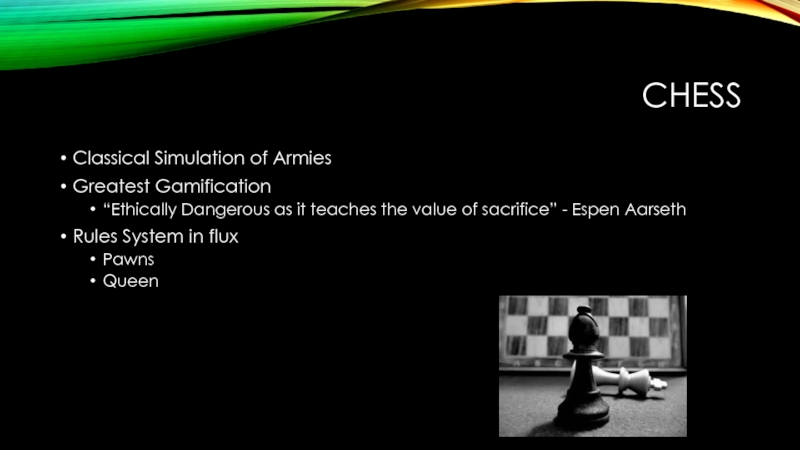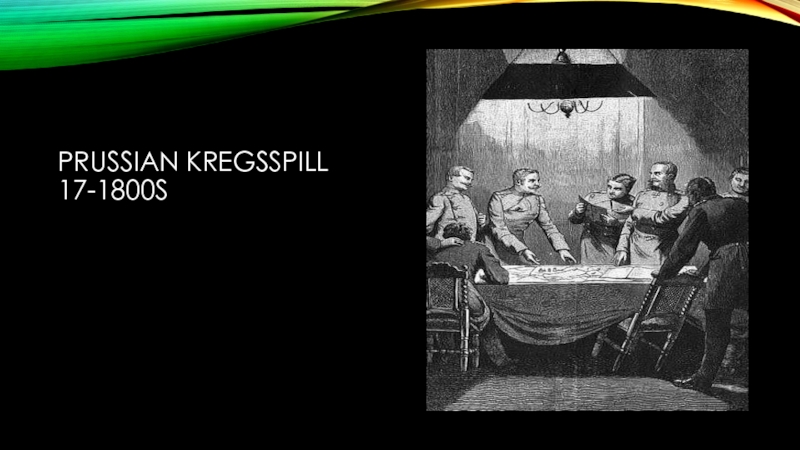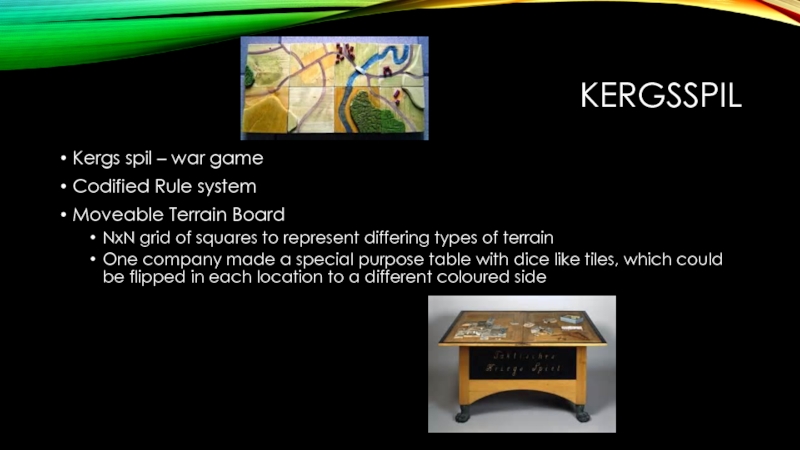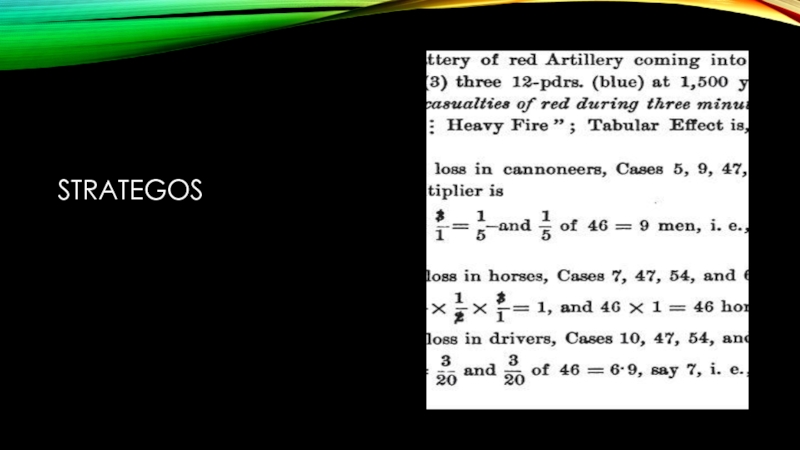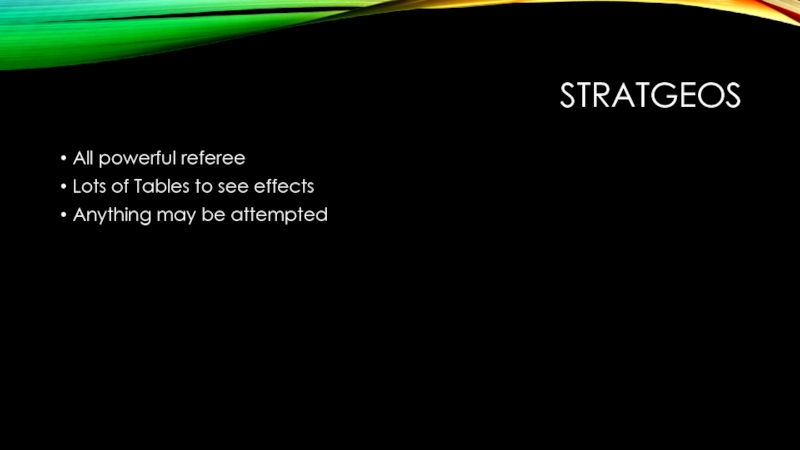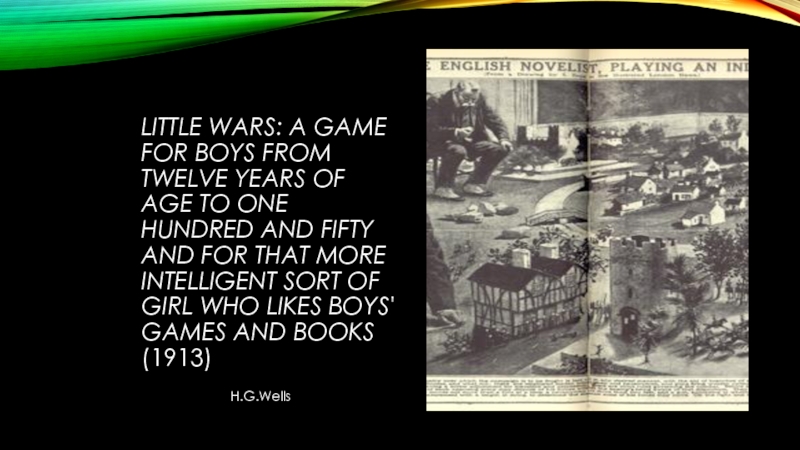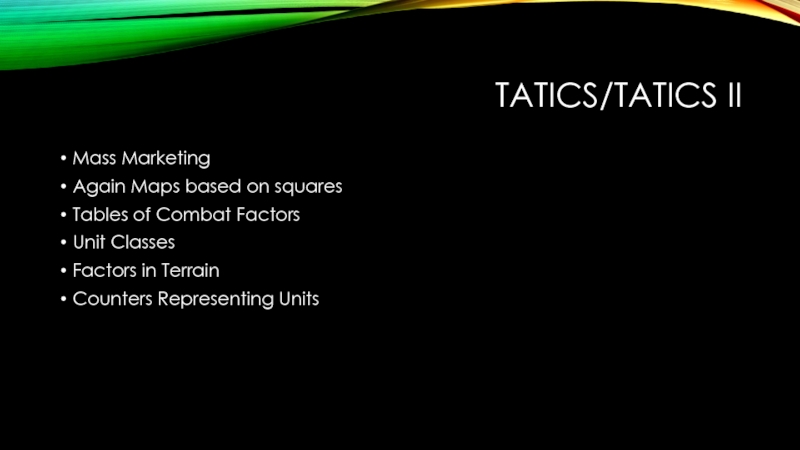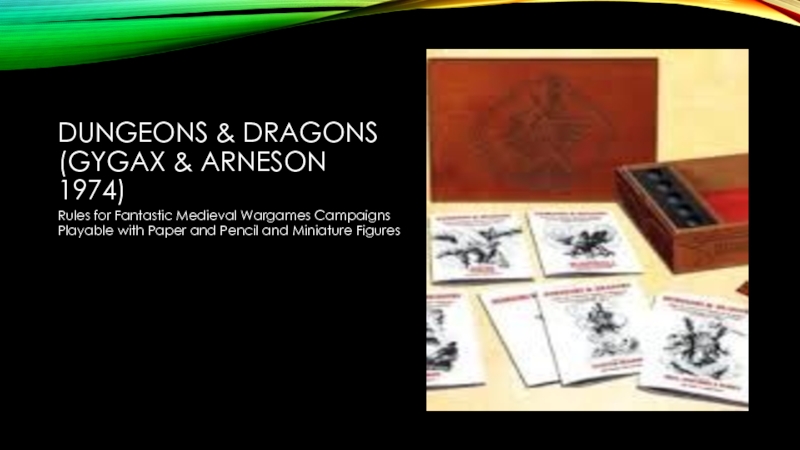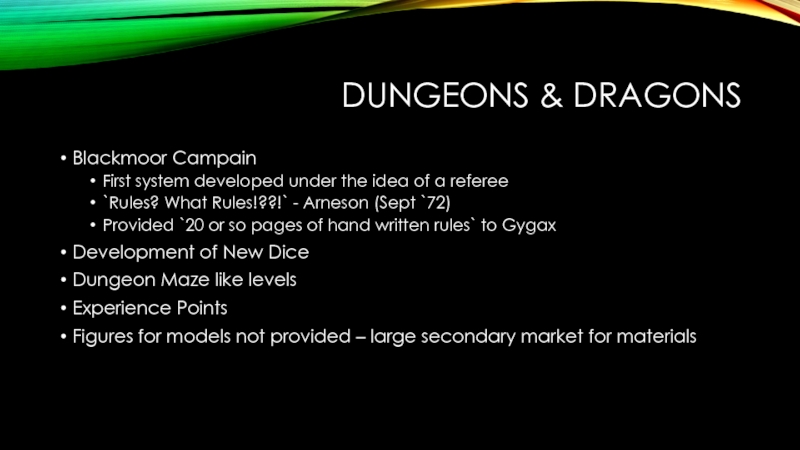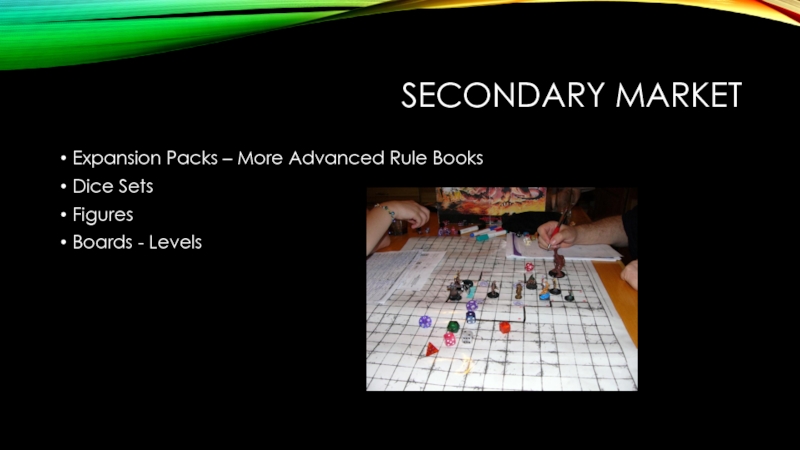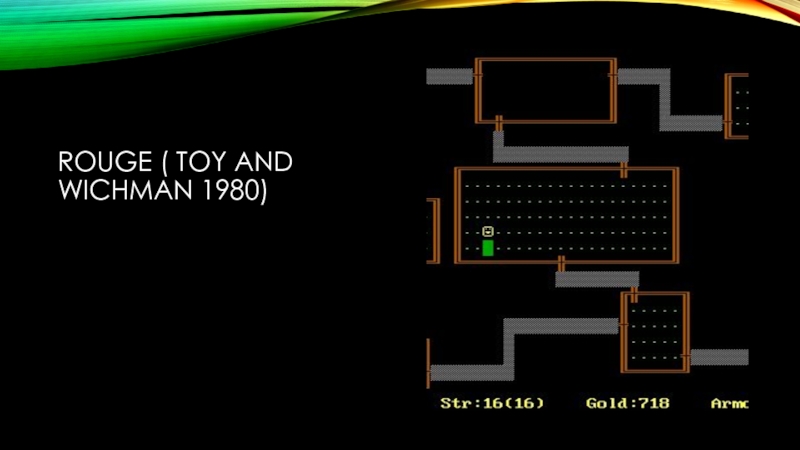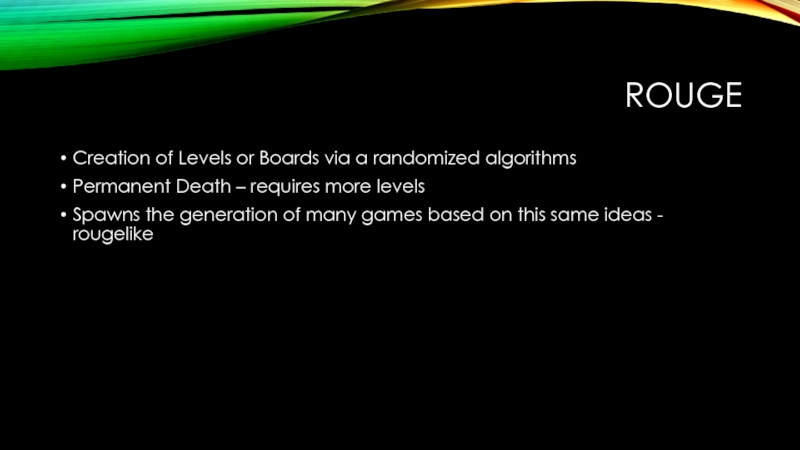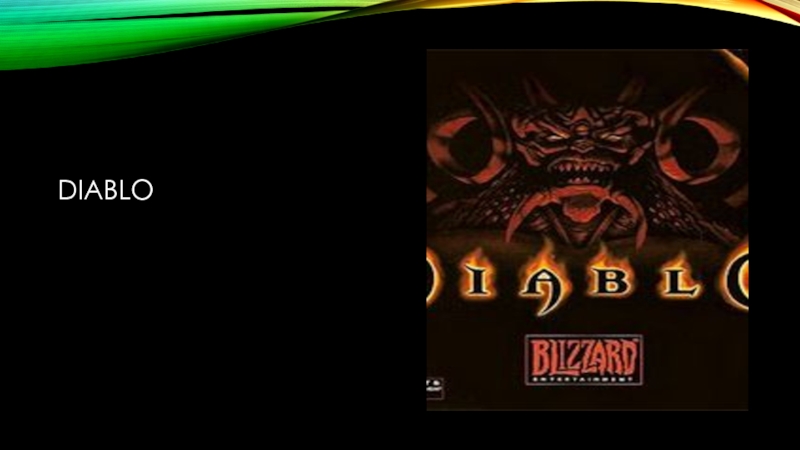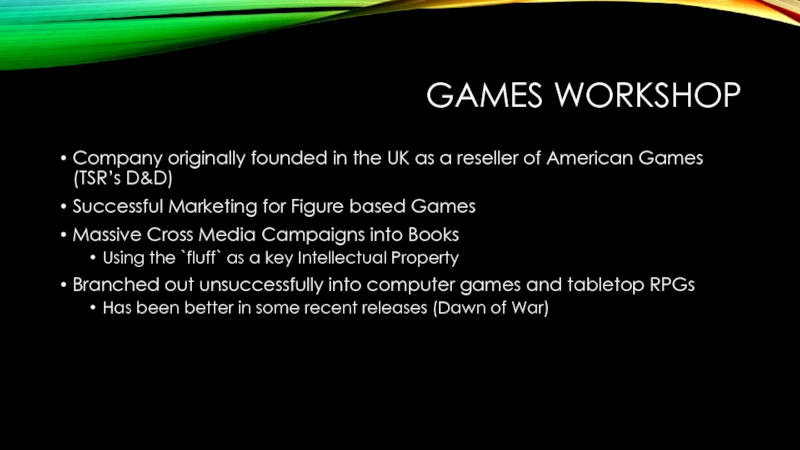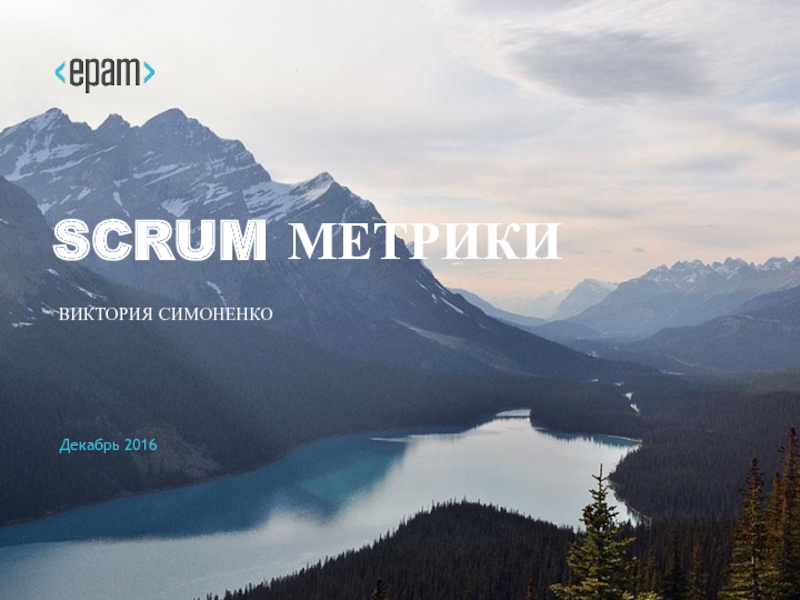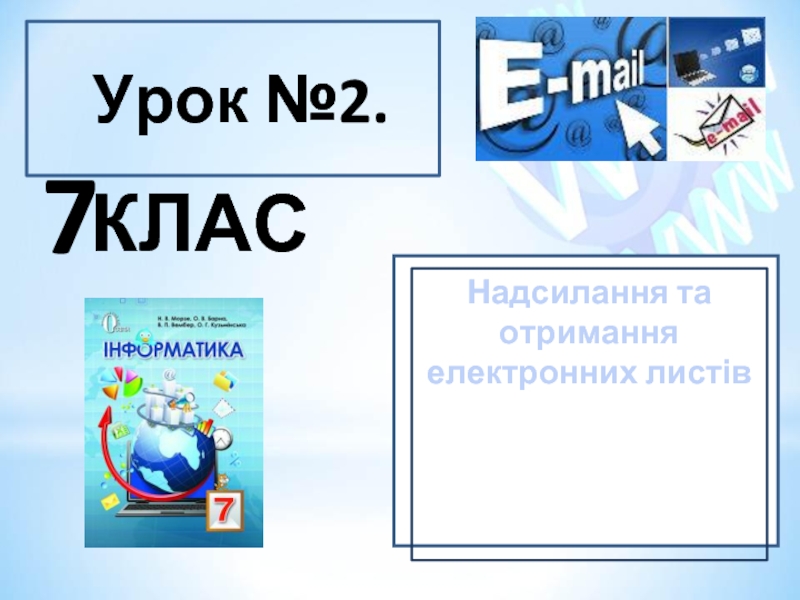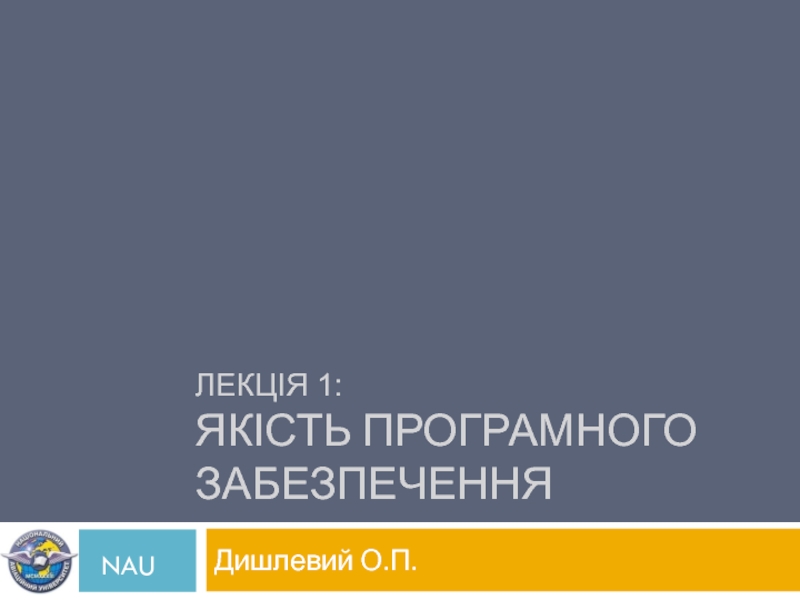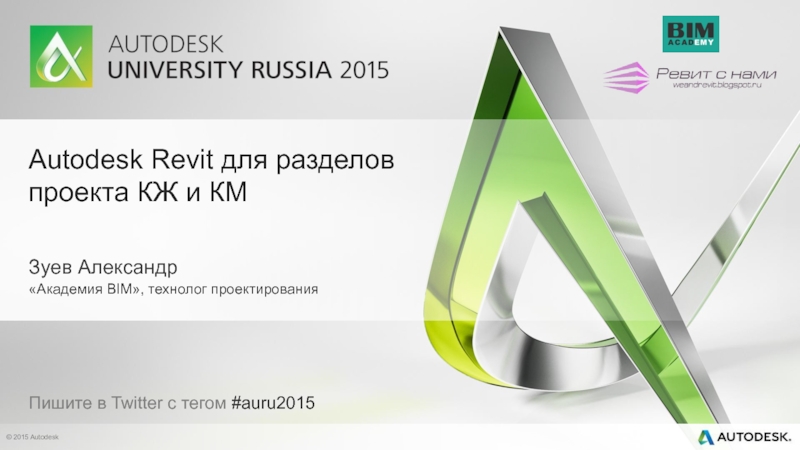- Главная
- Разное
- Дизайн
- Бизнес и предпринимательство
- Аналитика
- Образование
- Развлечения
- Красота и здоровье
- Финансы
- Государство
- Путешествия
- Спорт
- Недвижимость
- Армия
- Графика
- Культурология
- Еда и кулинария
- Лингвистика
- Английский язык
- Астрономия
- Алгебра
- Биология
- География
- Детские презентации
- Информатика
- История
- Литература
- Маркетинг
- Математика
- Медицина
- Менеджмент
- Музыка
- МХК
- Немецкий язык
- ОБЖ
- Обществознание
- Окружающий мир
- Педагогика
- Русский язык
- Технология
- Физика
- Философия
- Химия
- Шаблоны, картинки для презентаций
- Экология
- Экономика
- Юриспруденция
PCG Week. Procedural content generation for games and other design applications презентация
Содержание
- 1. PCG Week. Procedural content generation for games and other design applications
- 2. PRESS START
- 3. ABOUT Started Programming in High School Brock
- 4. ABOUT University of Guelph PhD 2014 Thesis
- 5. ABOUT I enjoy gamming Warhammer 40K Weekly
- 6. CONTACT INFORMATION Email j.brown@innopolis.ru I will respond
- 7. PLAGIARISM AND CHEATING Hurts yourself and
- 8. FORMAT OF GRADES 40% Portfolio Assessment 60%
- 9. IMPORTANT DATES TBA
- 10. OUTLINE • Textures and Landscapes • Level Design Methods
- 11. OTHER POLICY TBA
- 12. WHAT DID WE LEARN? Prof. Brown’s contact
- 13. SURVEY https://www.surveymonkey.com/s/YM5HRDB
- 14. WHY PCG? Hi…You’re here…good… we got a problem… A big one - Fallout Opening
- 15. DEFINITION OF PCG Togelius et al. (2011)
- 16. DEFINITION OF PCG PCG Wiki Procedural content
- 17. DEFINITION Has a notion of creation not
- 18. PCG CLAIMS PCG is Necessary to make
- 19. NOT NECESSARY AAA games do not rely
- 20. NOT FAST/CHEAP Takes time to make a
- 21. NOT UNIQUE Generated content by definition was
- 22. HUMAN CONTENT IS BETTER Content produced by
- 23. REPLAY-ABILITY SUFFERS Creates a formulaic mission Fetch
- 24. USERS NEEDS ARE NOT MET BY THE
- 25. WHY USE PCG? This has been my
- 26. IT IS NOT THE BEST DESIGN… BUT
- 27. INDEPENDENT GAMES Small Staff Need more content
- 28. BINDING OF ISSAC
- 29. FTL
- 30. SPELUNKY
- 31. MINECRAFT
- 32. FOCUS ON STRENGTHS PCG is not a
- 33. WHAT DID WE LEARN? Examined definitions of
- 34. SURVEY https://www.surveymonkey.com/s/YM5HRDB
- 35. HISTORY OF SIMULATION AND WAR GAMES
- 36. SHORT HISTORY OF WAR/ROLEPLAYING GAMES Unreason Press, 2012 Excellent Overview of Games
- 37. WARNING Summary of a Summary This is
- 38. PRE-HISTORICAL EXAMPLES Dice and Game Boards in
- 39. CHESS Classical Simulation of Armies Greatest Gamification
- 40. PRUSSIAN KREGSSPILL 17-1800S
- 41. KERGSSPIL Kergs spil – war game Codified
- 42. STRATEGOS
- 43. STRATGEOS All powerful referee Lots of Tables to see effects Anything may be attempted
- 44. LITTLE WARS: A GAME FOR BOYS FROM
- 45. TATICS/TATICS II (AVALON HILL 1954/8)
- 46. TATICS/TATICS II Mass Marketing Again Maps based
- 47. DUNGEONS & DRAGONS (GYGAX & ARNESON 1974)
- 48. DUNGEONS & DRAGONS Blackmoor Campain First system
- 49. SECONDARY MARKET Expansion Packs – More Advanced
- 50. ROUGE ( TOY AND WICHMAN 1980)
- 51. ROUGE Creation of Levels or Boards via
- 52. DIABLO
- 53. DIABLO All the classical elements of D&D
- 54. WARHAMMER SERIES (GAMES WORKSHOP –FOUNDED 1975, MINIATURES
- 55. GAMES WORKSHOP Company originally founded in the
- 56. HISTORICAL DIRECTIONS Codification of rules Anything may
Слайд 1PROCEDURAL CONTENT GENERATION FOR GAMES AND OTHER DESIGN APPLICATIONS
Prof. Joseph Alexander
Слайд 3ABOUT
Started Programming in High School
Brock University
BSc (Hons) 2007
First Class
Designation in Software
MSc 2009
Thesis on creation of Finite State Machines for problems in Biology
Teaching Assistant
Introductory Computer Science
Instructor
Adjunct Professor
Слайд 4ABOUT
University of Guelph
PhD 2014
Thesis on applications of the idea of extinction
Magna International
Car plant responsible for the production of front and rear fascia and side panels (aka Bumpers)
Statistical Modeling, Defect Modeling, Continuous Improvements
Слайд 5ABOUT
I enjoy gamming
Warhammer 40K
Weekly Table Top Roleplay Group
PC/Xbox/PS
Watch a number of
The Creatures
The Derp Crew
Game Grumps
Слайд 6CONTACT INFORMATION
Email
j.brown@innopolis.ru
I will respond to all emails from official University Accounts
Office Hours
TBA
Open Door Policy
Or by appointment
Слайд 7PLAGIARISM AND CHEATING
Hurts yourself and the class/community
Yourself: No understanding of the
Classmates: Not given proper or fair evaluation
Value of the degree: Employers and Peers see your actions reflected back on the institution
Professor: Lack of ability to fairly evaluate progress of class and apply remediation
Citation should be made in code or written works
Class notes, class slides, etc. Will be considered common knowledge
Слайд 8FORMAT OF GRADES
40% Portfolio Assessment
60% Project
10% Project Proposal
20% Oral Examination of
30% Project and Documentation
Слайд 10OUTLINE
• Textures and Landscapes
• Level Design Methods
• Asset Creation and Evaluation
• Ensuring Playability and Player
• Storyline Generation
• Computational Creativity
• Other Application Domains
• Building Worlds
Слайд 12WHAT DID WE LEARN?
Prof. Brown’s contact information
We set up some rules
We have a sense of the direction of our inqury
Слайд 15DEFINITION OF PCG
Togelius et al. (2011)
Procedural content generation (PCG) in games
Wikipedia
In computer graphics, procedural generation is generating content algorithmically rather than manually. In video games this means graphic content for a game can be created by the host computer, instead of prerendered artwork being included with the game package.
Слайд 16DEFINITION OF PCG
PCG Wiki
Procedural content generation (PCG) is the programmatic generation
Ian Parberry
Procedural content generation is the automatic creation of video game content, where content means anything that is traditionally created by an artist or a designer, such as maps, textures, levels, and objects. Content creation usually requires equal parts creativity and scutwork. The aim of procedural content generation is to relieve the designer of the scutwork in ways that create more opportunities for creativity.
Слайд 17DEFINITION
Has a notion of creation not by a designer but by
Notion of what processing element is creating the content (online or offline)
Creativity! v. Scutwork
Random content
Game SPACES
Слайд 18PCG CLAIMS
PCG is Necessary to make good games
Rougelikes, Civilization levels, etc.
PCG
Less time required to develop levels, characters, narrative
PCG allows for unique game experiences
Provides levels
PCG creates new content which a human would not make
Huge Search Spaces can be explored for content
PCG can extend replay value
Content is created on the user’s system, new levels and quests can be constantly added
PCG can meet with user requirements for level design – meeting with play styles
User feedback can be measured and new content can be presented which meets with the user’s enjoyment
Слайд 19NOT NECESSARY
AAA games do not rely on PCG for core game
Many of these core assets are developed by designers and
There is a large number of good designers who make these games
Слайд 20NOT FAST/CHEAP
Takes time to make a good generator
Large initial cost in
Easier to just hire more developers
Game developers are some of the hardest worked developers
EA games voted in 2012 as the worst employer in America
Constant complaints by programmers in the industry
Why hire someone who is specialized?
Слайд 21NOT UNIQUE
Generated content by definition was the output of a generator
The designer could have made the content directly
Lots more freedom and control when you are programming each element from scratch
Слайд 22HUMAN CONTENT IS BETTER
Content produced by a generator might be broken,
Content produced by humans directly meets with the demands of the story, a creative team ensures the context
Technology for a number of applications like narrative generation is simplistic or formulaic – stories made by humans are free from constraints
Can do very fine detail work with humans
Слайд 23REPLAY-ABILITY SUFFERS
Creates a formulaic mission
Fetch and kill quests
Really, I have to
Is this level even complete?
How does this fit with the narrative?
Слайд 24USERS NEEDS ARE NOT MET BY THE CONTENT
This level is too
Hard
Easy
Annoying
Human
Слайд 25WHY USE PCG?
This has been my driving question in my time
Papers, Books, Talking to Academics, Taking to Industry, etc.
Four months of wondering:
Why has PCG not lived up to a single promise which has been given for the field – to make games design better
Слайд 26IT IS NOT THE BEST DESIGN…
BUT IT CAN BE…
PCG works well
Rougelikes
Space Epics
Speed Tree
Academics are behind Industry – but we don’t need to be – the issue is how we approach the problem
It is not enough to make a generative method – the problem is how to demonstrate the effectiveness of the generative method
Слайд 27INDEPENDENT GAMES
Small Staff
Need more content per hour of work
Need games which
Simpler game mechanics –
Smaller content space
Less critical code areas
Willing to invest more in the process not just the product
Слайд 32FOCUS ON STRENGTHS
PCG is not a magic bullet – it should
It is a force multiplier when used well
Time spent in the making of a PCG generator needs to make content which is going to be of high quality
Use it is a gameplay mechanic – roguelikes
PCG does not excuse poor mechanics or bad designs
It is a tool – the designer needs to apply it when it suits the needs of the situation
Слайд 33WHAT DID WE LEARN?
Examined definitions of PCG
Algorithmic creation of creative content
Looked
PCG is not a magic bullet for a designers ills – but a useful tool
Saw some of the exciting Independent Games using the technology
Слайд 37WARNING
Summary of a Summary
This is a overview of exemplars
Might not
See them as representatives of the Progressions
Слайд 38PRE-HISTORICAL EXAMPLES
Dice and Game Boards in Egyptian Tombs
Chess like games in
Слайд 39CHESS
Classical Simulation of Armies
Greatest Gamification
“Ethically Dangerous as it teaches the value
Rules System in flux
Pawns
Queen
Слайд 41KERGSSPIL
Kergs spil – war game
Codified Rule system
Moveable Terrain Board
NxN grid of
One company made a special purpose table with dice like tiles, which could be flipped in each location to a different coloured side
Слайд 44LITTLE WARS: A GAME FOR BOYS FROM TWELVE YEARS OF AGE
H.G.Wells
Слайд 46TATICS/TATICS II
Mass Marketing
Again Maps based on squares
Tables of Combat Factors
Unit Classes
Factors
Counters Representing Units
Слайд 47DUNGEONS & DRAGONS (GYGAX & ARNESON 1974)
Rules for Fantastic Medieval Wargames
Слайд 48DUNGEONS & DRAGONS
Blackmoor Campain
First system developed under the idea of a
`Rules? What Rules!??!` - Arneson (Sept `72)
Provided `20 or so pages of hand written rules` to Gygax
Development of New Dice
Dungeon Maze like levels
Experience Points
Figures for models not provided – large secondary market for materials
Слайд 51ROUGE
Creation of Levels or Boards via a randomized algorithms
Permanent Death –
Spawns the generation of many games based on this same ideas - rougelike
Слайд 53DIABLO
All the classical elements of D&D games
Character Class/Level
Experience Points
No Games Master
No
Слайд 54WARHAMMER SERIES (GAMES WORKSHOP –FOUNDED 1975, MINIATURES IN 1979 AND THEN
Warhammer, Warhammer 40K, Lord of the Rings
Слайд 55GAMES WORKSHOP
Company originally founded in the UK as a reseller of
Successful Marketing for Figure based Games
Massive Cross Media Campaigns into Books
Using the `fluff` as a key Intellectual Property
Branched out unsuccessfully into computer games and tabletop RPGs
Has been better in some recent releases (Dawn of War)
Слайд 56HISTORICAL DIRECTIONS
Codification of rules
Anything may be attempted is restricted over time
Rules
House Rules
Technology
Military Elite to Pass time
Was never – Just for Kids
Marketing to the youth as a brand experience
Simplicity of Design to Complexity
Chess Set -> Military Figures
Characters as letters -> Full 3D models
Marketing of fluff, models, dice, etc.
